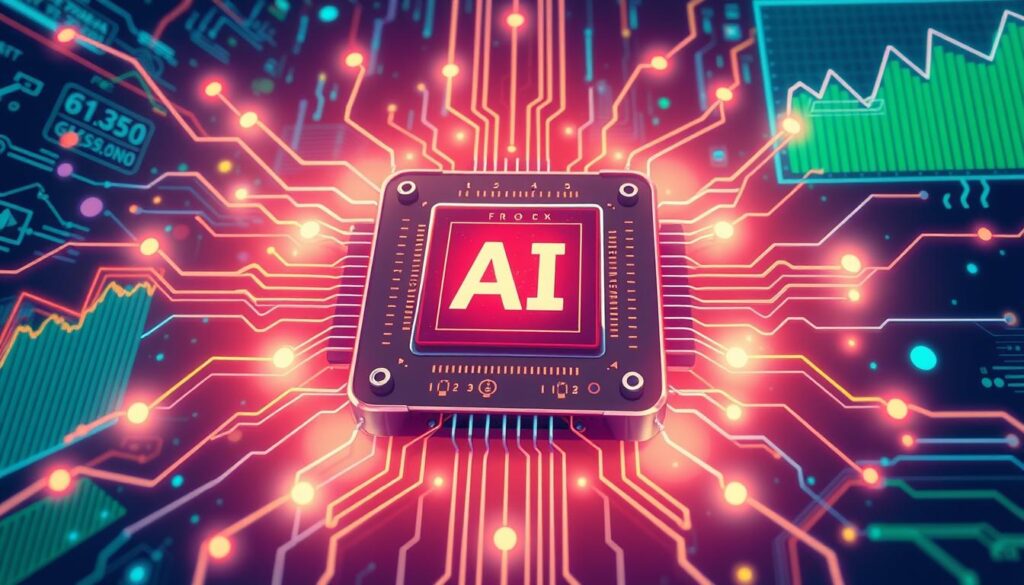By 2028, US utilities might need to boost energy generation by 7% to 26% more than in 2023. This shows how fast data centers’ power needs are growing. The rise of AI is driving this demand, as more businesses use it for insights, automation, and better customer service.
Data centers are leading this change, with their electricity demand growing the most in the US. They could use more than double the energy they did in 2023 by 2027. This rapid increase threatens to overwhelm the power grid, posing a big challenge for data centers and utilities.
Key Takeaways
- Data centers’ energy consumption could more than double by 2027, driven by the surge in AI-powered technologies.
- US utilities may need to increase annual energy generation by up to 26% by 2028 to meet projected data center demand.
- AI-driven technologies within data centers are optimizing resource allocation, predictive maintenance, and security measures to improve operational efficiency.
- Colocation services with AI-enhanced management are becoming more attractive for businesses with demanding AI workloads.
- Implementing AI in data centers can significantly reduce operational costs and improve energy efficiency.
Current State of Data Center Power Consumption
The growth of AI Energy Consumption and AI Hardware Acceleration has greatly increased data center power needs. Data centers in the U.S. now use 3-4% of the total power. But, this number is expected to jump to 11-12% by 2030.
This rise is due to more advanced AI workloads. These require a lot of computing power and energy.
Global Power Usage Statistics
The data center industry is set for huge growth worldwide. Demand for data center capacity is expected to grow by 19-22% each year from 2023 to 2030. By the end of the decade, the global demand could reach 171 to 219 gigawatts (GW), up from 60 GW now.
In the U.S., data center demand is forecasted to jump from 25 GW in 2024 to over 80 GW by 2030. This will need over $500 billion for new capacity.
Impact of AI on Traditional Data Centers
Managing power in data centers has become key with AI’s power needs. Training models like ChatGPT can use over 80 kilowatts (kW) per rack. Nvidia’s latest AI hardware might need up to 120 kW per rack.
This is a big jump from the traditional 8 kW per rack. Now, data centers use 17 kW per rack, and this could reach 30 kW by 2027.
Power Density Evolution in Modern Facilities
The rise in power density in data centers has led to a need for new strategies. By 2030, about 70% of data center demand will be for advanced AI workloads. Gen AI will make up about 40% of this demand.
This makes Data Center Power Management a big challenge. It requires new solutions to provide reliable and sustainable power for these AI operations.
AI Power Demand in Data Centers
The need for AI-ready data centers is growing fast, with a 33% annual increase expected from 2023 to 2030. By 2030, 70% of data center needs will be for advanced-AI workloads. Generative AI, the fastest-growing AI type, will make up about 40% of this demand.
Cloud service providers are leading the increase in AI data center demand. They are driving the need for more AI-ready data centers.
Electricity is a big part of data center costs, making up 46% of spending for enterprise centers and 60% for service provider centers. The energy use for AI Power Demand in Data Centers is expected to grow fast. It will increase by 44.7% annually, reaching 146.2 Terawatt hours (TWh) by 2027.
| Metric | Projection |
|---|---|
| AI Datacenter Capacity CAGR | 40.5% through 2027 |
| AI Datacenter Energy Consumption CAGR | 44.7% through 2027 |
| Global Datacenter Electricity Consumption CAGR | 19.5% from 2023 to 2028 |
The growth in AI Computing Infrastructure and AI Workload Optimization is driving the power demand surge. New AI chips from Nvidia, AMD, Intel, and others are very power-hungry. The next chips could use up to 1,500W or more each.
Data center operators face a big challenge with the rapid growth in AI power demand. They need to make sure their facilities are ready for the future. They must ensure reliable, sustainable, and affordable power. New solutions in power infrastructure, energy efficiency, and renewable energy will be key to meeting this demand.
Unprecedented Growth in Energy Requirements
The rise of AI has led to a big jump in energy needs for data centers. The U.S. is expected to see a huge increase in data center power needs by 2030. This growth will make data centers use 11-12% of the U.S. power demand, up from 3-4% today.
Projected Power Demand Through 2030
The U.S. market is set to grow from 25 GW in 2024 to over 80 GW by 2030. This is a huge jump. Electricity demand for data centers in the U.S. will rise by about 400 terawatt-hours, growing at a rate of 23% each year from 2024 to 2030.
Comparison with Traditional Computing Loads
The growth in AI Energy Consumption is much faster than traditional computing. Data centers now use just over 1% of the world’s electricity. But by 2030, this will double because of more AI Computing Infrastructure.
Impact on National Power Grids
The power needs for AI are huge and are challenging national power grids. Experts say the U.S. will need around $2 trillion to update the grid. This will help add more renewable energy and meet data center demands.
“By 2030, data centers are projected to consume 8% of power in the United States, requiring an investment of up to $50 billion for just data centers.”
Infrastructure Challenges and Bottlenecks
The need for Data Center Power Management and AI Computing Infrastructure is putting a strain on the power grid. Data centers are now needing huge amounts of power. Hyperscale facilities want 300-1,000 MW of power, and they need it fast, in just one to three years.
This rapid growth is making it hard for local grids to keep up. They struggle to supply the power needed on time.
The power demands from data centers, especially those using Energy-Efficient AI Solutions, are a big worry. Large language models (LLMs) are using a lot of energy. This is pushing the limits of our current infrastructure.
Big names like Amazon, Google, Meta, OpenAI, Digital Realty, and QTS are working with the U.S. Department of Energy. They aim to tackle these power supply bottlenecks.
| Recent Data Center Projects | Investment Amount |
|---|---|
| Microsoft center in Indiana | $1 billion |
| Meta center in Alabama | $800 million |
| Digital data center in Dulles, Virginia | $630 million |
New data center projects are getting big investments. But, the industry is facing power distribution issues and supply chain delays. Larry Ellison from Oracle has talked about delays in data center projects. These delays are due to problems getting generators, power supply systems, and other critical components.
The Department of Energy suggests creating a data center AI testbed. This would help develop energy-efficient AI algorithms with national labs, academia, and industry. They also recommend a quick look at costs, performance, and supply chain issues in power generation, storage, and grid technologies. This is to help data centers grow regionally.
The report talks about data centers becoming active in grid management. This could help use energy better. It suggests using clean energy technologies like advanced nuclear, enhanced geothermal, and long-duration energy storage. This would help data centers grow sustainably.
Power Supply and Distribution Solutions
Data centers face a big challenge with the power needs of AI Computing Infrastructure. New solutions are coming to solve power supply and distribution problems. It’s important to consider grid connections, power upgrades, and regional power issues for reliable and efficient Data Center Power Management.
Grid Connection Strategies
Utilities are finding it hard to keep up with data center growth. This has led to worries about enough power generation and transmission. Some utilities offer power in small steps, increasing as they build more infrastructure.
However, this can cause delays and uncertainty for data center owners. In places like Ireland, new data center grid connections have been stopped until 2028. This is due to grid strain and climate target concerns.
Power Infrastructure Upgrades
Data center operators are upgrading power infrastructure to meet Cooling Systems for AI Data Centers needs. Busway systems can be updated to monitor power, helping find ways to save energy and improve reliability. Specialized power solutions are also needed in areas with lots of AI servers to manage power and heat.
Regional Power Availability Issues
The location of data centers and reliable power supply are key. The strongest power demand growth is forecasted in areas like PJM South (7.4% per year) and ERCOT (2.9%). Solving these regional power issues is crucial for Data Center Power Management and AI Computing Infrastructure growth.
| Key Insights | Statistics |
|---|---|
| Projected Power Demand Growth |
|
| Strongest Regional Growth |
|
| Data Center Power Demand Estimates |
|
| Investment Needs |
|
Energy Efficiency Innovations
Data centers face a big challenge as AI workloads grow. They need to find ways to use less energy. Over the last ten years, they’ve made big strides in being more efficient. But, as AI gets more complex, it’s harder to keep up.
Energy-Efficient AI Solutions and AI Workload Optimization are key now. New cooling tech, like liquid cooling, helps a lot. It makes data centers use less energy. Also, finding ways to make concrete greener is important for reducing carbon emissions.
| Efficiency Improvement Strategies | Impact |
|---|---|
| Using Google’s Deepmind AI for analysis | 40% reduction in cooling costs |
| Microsoft’s AI algorithms for energy efficiency and dynamic workload scheduling | Significant improvements in energy efficiency |
| Huawei’s predictive analytics for a China data center | 8% reduction in energy consumption |
| San Francisco data center running on green power | 24 million pounds of CO2 emissions reduced per year |
More people are working together to make data centers greener. The Open Compute Project (OCP) is a big example. Their work, along with better AI Chip Power Efficiency, is vital. It helps data centers stay efficient as AI demands grow.
Sustainable Power Solutions for AI Workloads
The data center industry is working hard to cut down on carbon emissions. They are turning to Renewable Energy for Data Centers to reach carbon-free energy by 2030. Even though power grids are getting cleaner, natural gas use is expected to rise. Companies are using new ways to track their carbon footprint, like renewable-energy certificates and carbon matching.
Renewable Energy Integration
Data centers are now focusing on Energy-Efficient AI Solutions and using renewable energy. This change is needed because AI is growing fast and using more energy. By using solar and wind power, data centers can help make the world more sustainable.
Carbon-Free Energy Goals
Big data center companies aim to use only renewable energy. But, there’s no single way to do this yet. They are looking for new ways to get clean energy for their AI needs.
Green Technology Adoption
Data centers are also using Energy-Efficient AI Solutions and green tech. They are improving IT hardware and cooling systems. These steps help data centers use less energy and support the Renewable Energy for Data Centers industry.
“Achieving 24/7 carbon-free energy for data centers is a critical step in decarbonizing the global economy. Companies are exploring a range of solutions, from renewable energy integration to innovative power management technologies, to power their growing AI workloads sustainably.”
Geographic Distribution and Power Access
The need for AI Computing Infrastructure is growing fast. Data centers are spreading out to solve power issues and meet AI Power Demand in Data Centers. Training centers can be built in places far from cities, where power is easier to get.
But, finding space for new data centers is tough. In places like Northern Virginia, finding a spot is almost impossible. This is because there’s so much demand and not enough space for Data Center Power Management.
| Metric | Value |
|---|---|
| GPUs energy efficiency compared to CPUs | Up to 20 times higher for specific AI tasks |
| Nvidia GPU advancements vs CPUs energy efficiency | Up to 20 times better |
| Potential total energy demand growth in the U.S. in the next decade | 15-20% |
| Estimated growth in data center electricity demand by 2030 | 290 terawatt hours |
| Projected share of U.S. electricity generation consumed by data centers by 2030 | Up to 9% |
We need new ways to manage power in data centers. We also need to place AI Computing Infrastructure wisely. This ensures we have enough power everywhere.
Working together is key. We need to share knowledge and ideas. This will help us meet the AI Power Demand in Data Centers and keep our infrastructure strong for the future.
Future-Proofing Data Center Power Systems
Data centers are facing a big challenge as AI workloads grow. They need to make their power systems ready for the future. New solutions are coming up, focusing on better power tech and scalable setups.
Next-Generation Power Technologies
Data center managers are looking into new power tech to save energy and cut down on carbon emissions. AI Hardware Acceleration helps make AI work more energy-efficient. This means less power needed overall.
Energy-Efficient AI Solutions use smart cooling and power units to save energy. This makes the whole data center more efficient.
Companies like Google and Microsoft are using renewable energy like solar and wind in their data centers. New tech like hydrogen and liquid cooling is making data centers more sustainable and strong.
Scalability Solutions
- Modular data center designs that grow easily and adapt to changing AI needs.
- Smart power management systems that share resources wisely based on demand.
- Demand response programs and energy-saving plans that help the grid and save power.
To make data center power systems future-ready, everyone needs to work together. This includes data center owners, tech makers, grid managers, and regulators. By using new tech and scalable solutions, we can handle the AI power demand while keeping things reliable, efficient, and green.
Economic Implications of AI Power Demand
The economic impact of AI power demand is huge. McKinsey research shows generative AI could add $2.6 trillion to $4.4 trillion in value globally. To reach a quarter of this by 2030, the U.S. needs 50 to 60 GW of new data center power.
Building over 50 GW of new data center capacity in the U.S. by 2030 will cost more than $500 billion. This huge investment is needed because AI technology is growing fast and being used in many industries.
The rise in AI power demand in data centers will affect many areas. It will change energy costs, infrastructure spending, and the competitive scene. Data centers in places with cheap and reliable power will gain an edge. This could make electricity more expensive for those near AI data center clusters.






